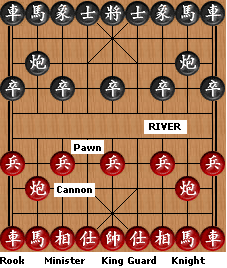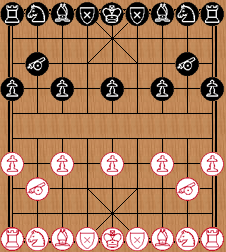CXQ Chinese Chess Rules
CXQ Chinese Chess Rules consist of three parts: (1) the basic rules telling which moves are allowed; (2) the advanced rules restricting certain moves to ensure fair games; (3) the drawing rules preventing games from being too long


One can move the pieces according to the following rules:
- The King moves only one space at a time, either horizontally or vertically. Furthermore, the King must always stay within the palace, which is a square marked with an X.
- The Guards (Advisor) move only one space at a time diagonally. Similar to the King, the guards must stay within the palace.
- The Ministers (Elephants) move two spaces at a time diagonally (i.e. 2 spaces left/right and 2 spaces up/down in a move). They must stay within their own side of the river. If there is a piece midway between the original and final intended position of a minister, the minister is blocked and the move is not allowed.
- The Rooks (Cars) move one or more spaces horizontally or vertically provided that all positions between the original and final positions are empty.
- The Knights (Horses) move two spaces horizontally and one space vertically (or respectively 2 spaces vertically and one space horizontally). If there is a piece next to the horse in the horizontal (vertical) direction, the horse is blocked and the move is not allowed.
- The Cannons move one or more spaces horizontally or vertically like a Rook. However, in a capture move, there must be exactly one non-empty space in between the original and final position. In a non-capture move, all spaces in between must be empty.
- The Pawns (or Soldiers) move one space at a time. If a pawn does not cross the river yet, it can only move forward vertically. Once crossing the river, the pawn can also move horizontally.
- Capture: When a piece moves to a position currently held by an opponent's piece, it captures that opponent's piece. The captured piece is removed from the board.
- King's line of sight: The two Kings in the board must never be on the same file (vertical line) without any pieces in between them. A move that puts the two Kings in such a setting is illegal.
- King safety: One must never leave the King to be captured by the opponent in the next move. Any moves that put the King in such a setting is illegal.
- Checkmate: If one threatens to capture the opponent's King and the opponent has no way to resolve the threat, one wins.
- Stalemate: If one does not have any valid move, one loses.
- One or both sides violate the Advanced Rules.
To make the games fair, certain patern of movements are restricted. In the nutshell, CXQ Rules prohibit a player to continuously threaten to capture one opponent's piece using one or more pieces. Such movements are either perpetual checks (if the King is threatened) or perpetual chases (if an unprotected piece other than the King is threatened).
Terminology: To make the rules precise, the following terms are used:
- Check: A move of any piece that causes the opponent's King to be threatened with capture in the next move.
- Same type sacrifice/trade: A piece moves to a position where it can capture an opponent's piece of the same type in such a way that the opponent piece can also capture it in the next move.
- Chase: A piece moves to a
position where it can capture an opponent's piece, which is not the King,
in the next move. It is also a chase when a piece moves and results in
a cannon attacking an opponent's piece. There are a few exceptions:
- It is not a chase when a King or a Pawn threatens to capture any piece.
- It is not a chase to threaten to capture a Pawn when it is yet to cross the river.
- Same type sacrifice/trade is not a chase.
- Protected: A piece is protected if there is a piece that can capture any piece that takes the protected piece. An exception is that a car is never considered protected when it is threatened by an opponent's cannon or knight.
The CXQ Advanced Rules: All moves following the basic rules are allowed except:
- Perpetual Check: Continuously checking opponent using one or more pieces is not allowed.
- Perpetual Chase: Continuously chasing one unprotected opponent piece using one or more pieces is not allowed.
CXQ allows a player to check/chase 6 consecutive times using one piece,
12 times using 2 pieces, and 18 times using 3 pieces before considering
the check/chase a perpetual check/chase.
When the game is not winnable, it is strongly recommended that both players draw the game by themselves. To prevent one or both players from dragging the games for a long time, CXQ imposes the following 3 rules for automatic drawing:
- Effective Rule: When the total number of effective moves, moves made by each side excluding checking/chasing moves or moves to respond to checking/chasing, reaches 120.
- Progress Rule: When the total number of moves by each side since the last time a progress is made, i.e. since (1) the last capture or (2) the last advance of a pawn already crossed the river, reaches 30.
- Moves Rule: When the total number of moves made by each side reaches 300. This rule is rarely used, but is here for completeness.
CXQ Advanced Rules are similar to Asian Chinese Chess Rules. CXQ's goal is to make the rules as easily understandable by an average player as possible. Those who wish to learn the rules more in detail are strongly recommended to check out Asian Rules.
Following are the judgement calls for common scenarios using the Advanced Rules:
- One (or many) checks one idle is allowed.
- One (or many) checks one chase is allowed.
- One (or many) chases one check is allowed.
- One (or many) chases one idle is allowed.
- One (or many) checks one threaten to checkmate is allowed.
- Perpetual chase two or more pieces is allowed.
- Perpetual blocking is allowed.
Note that a move is a violation if it violates the Advanced Rules in any way. For example, a perpetual blocking, if it is also a perpetual chase, is a violation even though perpetual blocking is allowed in general.
CXQ
Last modified 02/26/2004


